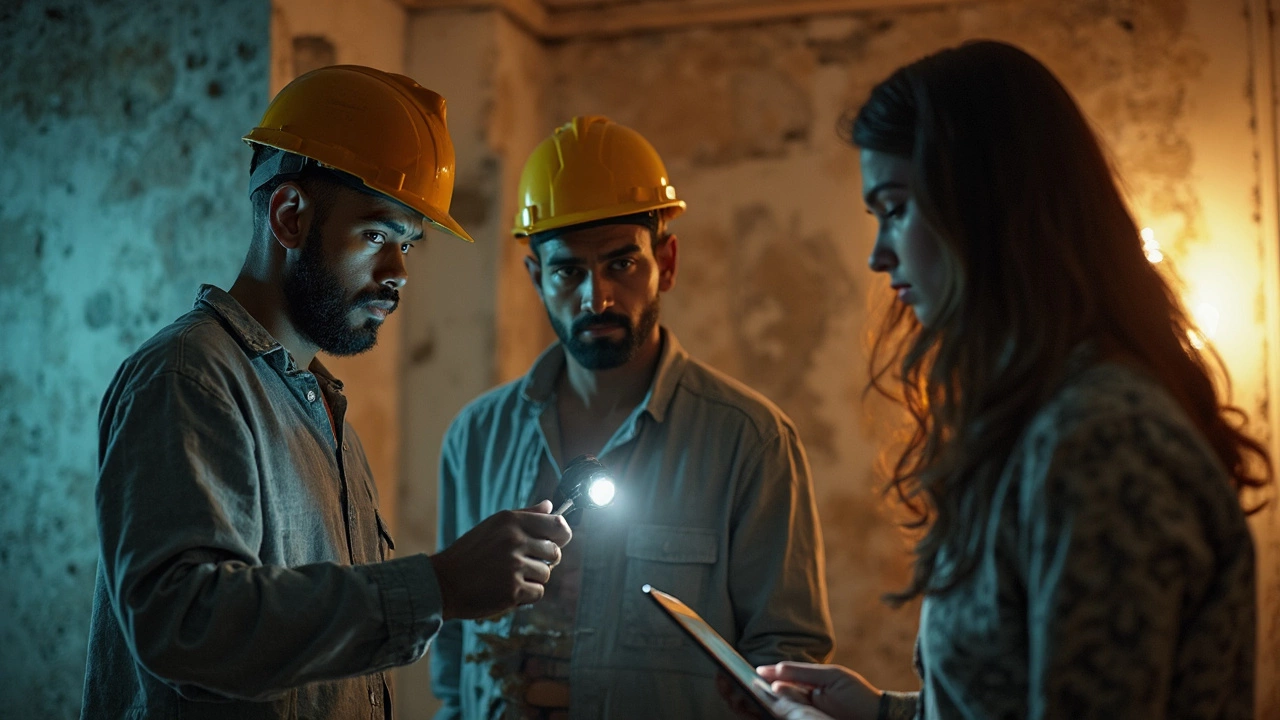Most homes settle a bit, but foundation problems are a whole different animal. You might spot cracks in walls or doors that won’t shut—and think, can this be fixed, or is it time to bail? Here’s the ugly truth: not every foundation issue is worth fighting for, especially if your wallet or sanity is on the line.
It’s easy to fall in love with a place, but foundation trouble turns dream homes into money pits fast. Your best move is to get clear on what’s a minor annoyance versus what will drain your savings. A few hairline cracks usually aren't the end of the world. But major shifting, wide gaps, or sloped floors? Those signal deeper issues that will haunt you long after move-in day.
Walk away triggers aren’t always obvious from the first look. The fix could be twice what the seller claims, or maybe repairs still won’t bring peace of mind—a sinking corner, persistent water leaks, or past shoddy repairs can stack up. There are some problems even the pros warn clients to avoid, no matter how low the price dips. So, when that uneasy gut feeling kicks in, it’s worth stopping to figure out if the foundation mess is someone else’s problem to handle, not yours.
- Why Foundation Problems Are a Big Deal
- Red Flags You Should Not Ignore
- When Repairs Don't Add Up
- Hidden Costs and Insurance Nightmares
- Expert Opinions: Where Pros Draw the Line
- Knowing When to Cut Your Losses
Why Foundation Problems Are a Big Deal
Foundation problems go way beyond a simple cosmetic issue. At their core, these troubles threaten the stability and safety of the entire house. If the base isn’t solid, pretty much everything else in the building can start failing, from flooring to the roof. Houses with foundation problems sometimes become expensive projects just to keep standing—forget about adding value or comfort.
Here’s what usually happens when foundation problems creep in:
- Cracked walls and ceilings start appearing—sometimes wide enough to slide a coin in.
- Doors and windows stick or refuse to close properly, making everyday life frustrating.
- Plumbing can break or leak when pipes shift with the foundation.
- You could see uneven floors that make furniture wobble or even mess up your balance.
The real kicker? According to the National Association of Realtors, foundation issues can chop as much as 15% off your home’s market value. Insurance is no hero here—homeowner policies usually won’t cover regular settling or most types of foundation repairs. This means repairs come straight out of your pocket.
| Common Foundation Problem | Potential Repair Cost (USD) |
|---|---|
| Small crack repair | $500 - $1,500 |
| Major foundation leveling | $5,000 - $15,000 |
| Complete foundation replacement | $25,000+ |
If you ever need to sell, buyers get spooked fast by words like “settling” or “foundation movement” on a report. Lenders may even refuse mortgages for homes with unresolved problems. So, fixing the foundation isn’t just about safety and comfort, it’s also about keeping your home’s value and your options open for the future.
If you’re thinking about investing anything—money or energy—into a house with foundation problems, you’ve gotta address these issues right out of the gate. Ignoring them only makes the problem (and the repair bill) grow bigger over time.
Red Flags You Should Not Ignore
Spotting foundation problems early isn’t about catching one wonky door or a single crack. The real trouble comes when you see a pattern of warning signs. Let’s be real—some of these red flags say "run for the hills" if you’re trying to avoid disaster, especially if you’re looking for a solid home and not a lifelong repair project.
- Foundation problems that show up as wide, stair-step cracks in brick or concrete blocks—especially those wider than a quarter-inch—mean the house could be shifting.
- Sloping or uneven floors (roll a marble, if it speeds across the room, that’s a hint). An inch or more of slope across a room usually isn’t just settling.
- Doors and windows that stick, won’t latch, or look crooked. One sticking door alone might be humidity, but a bunch is trouble.
- Gaps around window frames or exterior doors, especially if they’re bigger on one side than the other.
- Bulging or bowing walls in basements. These can mean pressure from outside soil is actually moving the walls inward—a major structural risk.
- Moisture in the crawl space, mildew smells, or visible mold. Water issues and foundation problems are best friends, and not the good kind.
- Piers or beams that look cracked, rotten, or have been “patched” with makeshift fixes like stacked wood or bricks.
Here’s a quick look at what foundation red flags can really mean for your wallet and timeline:
| Red Flag | Typical Cost to Fix | Time to Repair |
|---|---|---|
| Wide Stair-Step Cracks | $2,500–$8,000 | 2–7 days |
| Sloped Floors | $5,000–$15,000 | 1–3 weeks |
| Bowing Basement Walls | $4,000–$12,000 | 5–14 days |
| Water or Mold Issues | $2,000–$10,000 | 3–10 days |
| Cracked or Rotten Piers/Beams | $3,500–$10,000 | 1–2 weeks |
If you see several items from this list in the same house, that’s a sign to slow down and think carefully. Even experienced investors sometimes walk away from homes when they see repeating red flags or an impossible repair tab. Trust those signals—when you spot these, ask yourself if you’re buying a home or signing up for a full-time construction project.
When Repairs Don't Add Up
There’s a point when sinking money into foundation repair just doesn’t make sense. It’s not always about the repair being impossible—it’s that the price tag, time, and hassle outweigh whatever you stand to gain. Let’s break down what to watch for before you shell out big bucks for a fix that might never pay off.
First, look at the numbers. Foundation repair in the U.S. averages $4,500, but it’s common to see jobs go well over $10,000 for major issues. If the house is older or has tricky access (think tight crawlspaces or buried utilities), costs can skyrocket to $20,000 or more, especially if piers or entire foundation sections need replacement. Here’s how some typical repair costs stack up:
| Issue | Typical Cost Range (USD) |
|---|---|
| Minor cracks | $500 – $2,500 |
| Settlement repairs | $2,000 – $7,000 |
| Full piering/underpinning | $10,000 – $30,000 |
Now think resale value. A repaired foundation might not raise property values as much as you’d hope. A study by the National Association of Realtors found that even disclosed, fixed foundation issues can lower a home’s value by 10-15%. Buyers get wary, and some insurers won’t even write a policy after major fixes.
Also, do the math on temporary versus permanent solutions. Some "quick fixes" just slap a band-aid on the problem, like patching cracks without correcting the soil movement underneath. You could pay for repairs twice if the core problem isn’t solved. If contractors can’t guarantee the fix or won’t warranty their work long-term, that’s a huge red flag.
- Always ask for at least two independent estimates from reputable companies.
- Check if bids include fixing water drainage and soil issues, not just patching concrete.
- See if repair costs plus purchase price push you over local market values—you’re better off walking if they do.
One last thing: The foundation problems that come with ongoing water issues under the house almost never turn into a one-and-done bill. You’ll pay now, then again in a few years. If the gamble gives you more anxiety than excitement, that’s your sign it’s time to walk.

Hidden Costs and Insurance Nightmares
If you think the price tag on foundation repairs is bad, wait until you see the stuff nobody talks about upfront. One big issue? A lot of foundation problems don’t get covered by regular homeowner’s insurance. Most standard policies consider foundation damage a "maintenance issue," not an accident, especially if it’s from settling, poor drainage, or an old repair gone wrong. Only sudden events like earthquakes or floods (if you bought extra coverage) might be included, and even then, you better read the fine print.
Hidden costs sneak up fast. On top of obvious repairs, you might have to deal with:
- Re-plumbing, because pipes often crack or shift when the ground moves
- Fixing warped doors and windows so they’ll actually open and close again
- Replacing drywall, flooring, tile, or bricks that have popped loose or cracked
- Pest removal—termites and other bugs love damp, shifting spots under the house
Here’s another gut punch: major foundation problems can wreck your ability to get insurance at all. Some companies won’t touch a property with serious known issues until repairs are finished (and approved by a structural engineer). If you manage to get coverage, expect higher premiums or special exclusions that leave you hanging when you need help most.
If you’re thinking about long-term costs, don’t forget the resale nightmare. Buyers get skittish about ongoing repairs or insurance headaches. Your home’s value can take a big dive, or you could end up stuck paying for another round of fixes just to close a sale.
This is why understanding the true cost of foundation problems up front—beyond the contractor’s quote—is a dealmaker or breaker. Skipping this step can leave you buried in expenses and uninsurable when disaster strikes.
Expert Opinions: Where Pros Draw the Line
Foundation repair experts see these issues every day, and they don’t sugarcoat what’s worth saving and what’s not. If you ask a seasoned structural engineer, most will tell you there’s a solid line between normal wear and tear and walk-away territory. Cracks under a quarter-inch? Probably cosmetic. But anything wider, or if you see cracks running in a stair-step pattern in brickwork, it’s time to worry.
One geotechnical study from 2023 found that nearly 80% of homes with foundation movement had some kind of improper drainage or negative grading. A pro will flag this in a heartbeat because the cause—if not fixed—almost guarantees the problems will keep coming back, no matter how many times someone patches the cracks.
So, what do the pros say are the ultimate deal-breakers? Here’s a short list:
- Foundation settling more than an inch in any spot
- Windows or doors that can’t shut because of shifting, not just old age
- Horizontal cracks in basement walls (not just vertical)
- Evidence of past repairs that have failed, like epoxy or anchor plates getting pushed out again
- Serious moisture issues: standing water, mold, or obvious rot in beams/supports
Check out a quick rundown in the table below—what experts see versus what they walk away from:
| Foundation Sign | Expert Reaction | Why They Walk Away |
|---|---|---|
| Small Hairline Cracks | Monitor | Usually not a problem if dry and stable |
| Large or Growing Cracks (>1/4 inch) | Concerned | Signals major movement, likely to worsen |
| Repeated Failed Repairs | Skeptical | Underlying cause may be unfixable |
| Partial or Complete Wall Bowing | Red Flag | Can collapse; expensive and risky |
| Chronic Standing Water | Dealbreaker | Leads to mold, rot, ongoing repairs |
The punchline? Most pros say: If fixing the foundation problems will cost over 20% of the property’s value or keeps coming back, cut your losses. No amount of patching is worth endless headaches and a bottomless repair bill. Ask any reputable inspector—they’d rather lose a sale than see you stuck with a money pit.
Knowing When to Cut Your Losses
Sometimes, you just have to walk away, no matter how much you think a place has potential. Here’s how to know it’s time to put your energy—and money—elsewhere.
If your inspection report is filled with phrases like “extensive settlement,” “structural compromise,” or “foundation movement exceeds acceptable standards,” don’t ignore them. For example, if you see quarter-inch-wide cracks running from floor to ceiling, doors jamming throughout the house, and evidence of repeated patch jobs, those are pretty clear signs that the situation is serious.
The math rarely lies: in the U.S., average foundation problems can cost between $10,000 and $40,000 to fix, according to HomeAdvisor data from 2024. But that’s for fixes—not full-on rebuilds, which can rocket above $100,000 if structural beams, plumbing, and wiring are affected. At that point, unless you’re getting the house at a price so low it covers repairs plus some breathing room, it just doesn’t make sense to take the gamble.
- When your loan officer or insurer refuses to back the property without seeing repairs done first, consider that a hard stop. Most lenders simply won’t approve a mortgage on homes with major unresolved foundation problems.
- If the foundation has been fixed before but the same issues keep showing up, this is a massive red flag. Multiple repairs mean ongoing movement or moisture problems that might never truly go away.
- Sometimes you just don’t have the bandwidth—financially or emotionally—for a long, stressful repair process. If you’re not ready for construction chaos or budget overruns, it’s OK to pass.
One more thing: if the seller gets cagey when you ask for engineering reports or proof of professional repairs, take it seriously. Transparency matters—you deserve real answers and honest paperwork. If anything feels off about the deal, there’s no shame in walking away before signing on the dotted line.
Bottom line: Not every home is worth the battle. Being smart and realistic up front protects your savings, your sanity, and your long-term happiness.




Write a comment